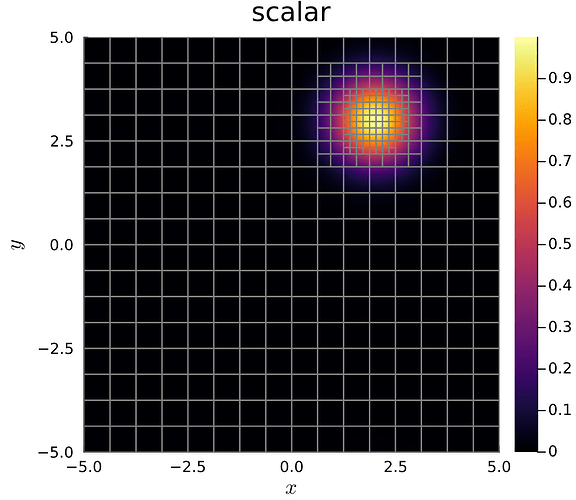I have followed the tutorial at 15 Adaptive mesh refinement · Trixi.jl and have tried different indicators on this problem: IndicatorMax, IndicatorLöhner and IndicatorHennemannGassner.
IndicatorLöhner does the opposite of the refinement i.e. if refines anything but the interesting region.
IndicatorHennemannGassner does provide acceptable refinement on the tutorial problem, but fails in my own problem, where again it refines everything but the regions that should be refined.
What is the proper way of using those indicators so that they automatically detect the regions that need refinements (i.e. regions where refinements will improve the error the most)?
Modified tutorial code and plot:
using Trixi
using OrdinaryDiffEq
advection_velocity = (0.2, -0.7)
equations = LinearScalarAdvectionEquation2D(advection_velocity)
# IDK why, but it is not provided in the tutorial
function initial_condition_gauss(x, t, equations::LinearScalarAdvectionEquation2D)
u = exp(-1 * (x[1]^2 + x[2]^2))
return SVector(u)
end
initial_condition = initial_condition_gauss
solver = DGSEM(polydeg = 3, surface_flux = flux_lax_friedrichs)
coordinates_min = (-5.0, -5.0)
coordinates_max = (5.0, 5.0)
mesh = TreeMesh(coordinates_min, coordinates_max,
initial_refinement_level = 4,
n_cells_max = 30_000)
semi = SemidiscretizationHyperbolic(mesh, equations, initial_condition, solver)
tspan = (0.0, 10.0)
ode = semidiscretize(semi, tspan);
#amr_indicator = IndicatorMax(semi, variable = first)
#amr_indicator = IndicatorHennemannGassner(semi, alpha_max=0.5, alpha_min=0.001, alpha_smooth=true, variable=first)
amr_indicator = IndicatorLoehner(semi, variable=first)
amr_controller = ControllerThreeLevel(semi, amr_indicator,
base_level = 4,
med_level = 5, med_threshold = 0.1,
max_level = 6, max_threshold = 0.6
)
amr_callback = AMRCallback(semi, amr_controller,
interval = 5,
adapt_initial_condition = true,
adapt_initial_condition_only_refine = true)
stepsize_callback = StepsizeCallback(cfl = 0.9)
callbacks = CallbackSet(amr_callback);
ode_solver = Tsit5()
#ode_solver = CarpenterKennedy2N54(williamson_condition = false) # needs stepsize_callback
sol = solve(ode, ode_solver;
dt = 1.0, # solve needs some value here but it will be overwritten by the stepsize_callback
ode_default_options()..., callback = callbacks);
using Plots
pd = PlotData2D(sol)
plot(pd)
plot!(getmesh(pd))
My problem - plot and code:
using Trixi
using OrdinaryDiffEq
using Statistics
using Plots
function sigmoid(x)
return 1.0 / (1.0 + exp(-x))
end
function ans_rect_pulse(x, t, a; s=16.0)
if a*t < x <= a*t + 1
# rising edge
z = (x - a*t) - 1/2 # range from -1/2 to 1/2
return sigmoid(z * s)
elseif a*t + 1 < x <= a*t + 2
# top
return 1.0
elseif a*t + 2 < x <= a*t + 3
# falling edge
z = (x - a*t) - 1/2 - 2 # range from -1/2 to 1/2
return sigmoid(-z * s)
else
return 0.0
end
end
function plot_ans(ans, t; x=0:0.01:10π)
y = ans.(x, t)
plot(x, y, label="analytical", xlabel="x", ylabel="u", title="Analytical Solution", size=(1200, 600), lw=1.5, color=:blue)
end
ode_solver = Tsit5()
tol = 1e-15
N = 4
K = 2^5
domain = (min = 0.0, max = 15)
tspan = (0.0, 1.0)
a = 5 # Advection velocity
ans_func = ans_rect_pulse
fig = plot_ans((x, t) -> ans_func(x, t, a), tspan[end]; x=domain.min:0.01:domain.max)
equations = LinearScalarAdvectionEquation1D(a)
coordinates_min = domain.min
coordinates_max = domain.max
mesh = TreeMesh(coordinates_min, coordinates_max, initial_refinement_level=Int(log2(K)), n_cells_max=10_000, periodicity=false)
solver = DGSEM(polydeg=N, surface_flux=flux_lax_friedrichs)
function initial_condition(x, t, equations::LinearScalarAdvectionEquation1D)
u = ans_func.(x, t, a)
return SVector(u)
end
function boundary_condition(x, t, equations::LinearScalarAdvectionEquation1D)
u = ans_func(x[1], t, a)
return SVector(u)
end
boundary_conditions = (
x_neg = BoundaryConditionDirichlet(boundary_condition),
#x_pos = BoundaryConditionDirichlet(boundary_condition)
x_pos = Trixi.BoundaryConditionDoNothing(), # it seems that the for LinearScalarAdvectionEquation1D x_pos is ignored anyway
)
semi = SemidiscretizationHyperbolic(mesh, equations, initial_condition, solver, boundary_conditions=boundary_conditions)
ode_trixi = semidiscretize(semi, tspan)
#amr_indicator = IndicatorMax(semi, variable = first)
#amr_indicator = IndicatorLoehner(semi, variable=first)
#amr_indicator = IndicatorHennemannGassner(semi, variable=first)
amr_indicator = IndicatorHennemannGassner(semi, alpha_max=0.5, alpha_min=0.001, alpha_smooth=true, variable=first)
Klog = Int(log2(K))
amr_controller = ControllerThreeLevel(semi, amr_indicator,
base_level = Klog,
med_level = Klog + 1, med_threshold = 0.1,
max_level = Klog + 2, max_threshold = 0.3)
amr_callback = AMRCallback(semi, amr_controller,
interval = 1,
adapt_initial_condition = true,
adapt_initial_condition_only_refine = true)
summary_callback = SummaryCallback()
callbacks = CallbackSet(summary_callback, amr_callback)
callbacks_benchmark = CallbackSet()
@time sol_trixi = solve(ode_trixi, ode_solver; abstol=tol, reltol=tol, callback=callbacks)
pd = PlotData1D(sol_trixi)
plot!(fig, getmesh(pd), label=false, lw=0.5)
plot!(fig, pd; size=(1200, 600), label="Trixi", legend=:topright, color=:red, lw=1.5)
display(fig)


